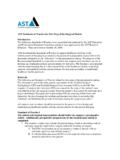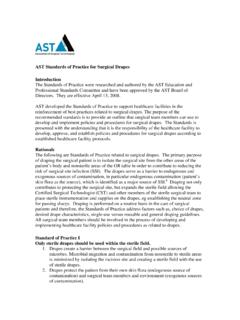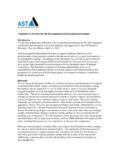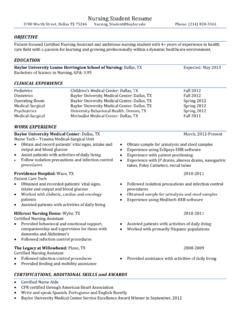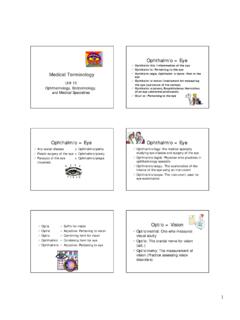Transcription of Basic surgical skills - WHO
1 Emergency and Essential surgical Care (EESC) programme 1 | MODULE 2 Basic surgical skills Emergency and Essential surgical Care (EESC) programme 2 | OBJECTIVES OF MODULE 2 To learn Basic surgical techniques surgical scrubbing Gowning and gloving for surgery Basic suturing techniques Treatment of various wounds Appropriate antibiotic use Treatment of burns Emergency and Essential surgical Care (EESC) programme 3 | ROUTES OF HIV TRANSMISSION Injury with needles or sharp instruments contaminated with blood, body fluids Contact between open wounds, broken skin (for example, dermatitis), mucous membranes, and contaminated blood, body fluids Transfusion of infected blood or blood products Emergency and Essential surgical Care (EESC) programme 4 | PREVENTING TRANSMISSION OF INFECTION Take care of your patients, your co-workers and yourself.
2 Do not recap needles Set up sharps containers where sharps are used Do not use same injection set on more than one patient Dispose of your own sharps Pass needles, scalpels, scissors with care and consideration Every hospital should have clear guidelines for management of injury or exposure to infectious materials Emergency and Essential surgical Care (EESC) programme 5 | INFECTION PREVENTION AND UNIVERSAL PRECAUTIONS Protect areas of broken skin, open wounds with watertight dressings Treat all body substances of all people as potentially infectious Clean blood spills immediately and safely Asepsis depends on standard procedures, staff training, personal discipline, attention to detail Trauma situations are chaotic, defenses are down, injuries happen quickly.
3 Precautions are often missed, forgotten, ignored Emergency and Essential surgical Care (EESC) programme 6 | INFECTION PREVENTION AND UNIVERSAL PRECAUTIONS Wear gloves during exposure to blood or body fluids, wash hands afterwards Wash immediately with soap and water in case of skin exposure, whether from a splash, glove puncture or non-gloved contact Wear protective glasses where blood splashes may occur; wash out eyes with water as soon as possible if splashed Wear protective gown or apron if splash potential exists Emergency and Essential surgical Care (EESC) programme 7 | INFECTION PREVENTION AND UNIVERSAL PRECAUTIONS Infection is the most important and preventable cause of impaired wound healing Microorganisms can reach tissues during surgery or manipulation of surgical wound carried and transmitted by: People, including patients Inanimate objects, including instruments, sutures, linen, swabs, solutions, mattresses, blankets Air around wounds, which can be contaminated by dust and droplets of moisture from anyone assisting at surgery or caring for wound Aseptic treatment of a wound.
4 An attempt to prevent bacterial contamination from these sources, during surgery, initial phase of healing Emergency and Essential surgical Care (EESC) programme 8 | OPERATING THEATRE Keep all doors to operating theatre closed except as needed for passage of equipment, personnel, patients Store some sutures, extra instruments Minimize number of people allowed to enter Keep room uncluttered, easy to clean Between cases, clean and disinfect table, instruments, surfaces Emergency and Essential surgical Care (EESC) programme 9 | Hand washing: the single most important measure for prevention of infection Plain soap and water is effective for removal of visible contaminants Wash with vigorous mechanical action on all hand surfaces for at least 40 seconds; washing above wrists, removing jewellery Nails are areas of greatest contamination Rinse under poured or running water HAND WASHING Emergency and Essential surgical Care (EESC) programme 10 | HOW TO HAND WASH To effectively reduce the growth of germs on hands, hand washing must last 40 60 s and should be performed by following all of the illustrated steps.
5 For further reference on clean care Emergency and Essential surgical Care (EESC) programme 11 | To effectively reduce the growth of germs on hands, hand rubbing must be performed by following all of the illustrated steps. This takes only 20 30 seconds! HOW TO HAND RUB For further reference on clean care Emergency and Essential surgical Care (EESC) programme 12 | SCRUBBING Remove jewellery Use soap, brush, running water to clean thoroughly around nails Scrub hands, arms up to elbows After scrubbing, hold up arms to allow water to drip off elbows Turn off tap with elbow Emergency and Essential surgical Care (EESC) programme 13 | SCRUBBING After scrubbing hands: Dry with sterile towel, make sure towel does not become contaminated Hold hands, forearms away from body and higher than elbows until putting on sterile gown and gloves Emergency and Essential surgical Care (EESC) programme 14 | GOWNING Place arms through sleeves Have a non-scrubbed assistant pull gown over shoulders so hands go through sleeves assistant will tie back of gown Emergency and Essential surgical Care (EESC)
6 Programme 15 | GLOVING surgical gloves prevent transmission of HIV and other infections through contact with blood, other body fluids Easiest to have someone who is already gowned and gloved to assist Promptly change a glove punctured during surgery, rinse hand with antiseptic or rescrub Emergency and Essential surgical Care (EESC) programme 16 | GLOVING without assistance Open sealed package of sterile gloves before scrubbing, gowning; place inner package on sterile surface Once gowned, take cuff of left glove with right hand (1); make sure thumb in correct position Slide glove onto left hand, wriggle fingers slightly to help Only touch inside of glove, cuff with bare hands Slide fingers of gloved left hand into cuff of right glove (2) Emergency and Essential surgical Care (EESC) programme 17 | GLOVING Pull glove onto right hand in similar fashion to placing left glove (3) Ensure that cuffs cover ends of both gown sleeves (4) Emergency and Essential surgical Care (EESC) programme 18 | INSTRUMENTS Many types of instruments Forceps, instruments for holding tissue Needle holders Scissors Retractors Which instrument to use?
7 Choose shortest instrument that will comfortably reach operative site If cutting suture or non-tissue material, avoid using fine scissors If possible, choose instruments in good repair Emergency and Essential surgical Care (EESC) programme 19 | INSTRUMENTS When holding instruments: Use three point control: have 3 points of contact between hand, instrument to increase precision Extend index finger along instrument to provide extra control, stability Place only fingertips through handle loops, rotation comes from wrist greater control quicker to pick up, put down Emergency and Essential surgical Care (EESC) programme 20 | INSTRUMENTS When using scalpel for dissection, use smaller knife hold instrument like a pen: thumb and third finger holding knife, with index finger controlling dissection Most procedures are performed with a #3 handle and #10 blade for large incisions #11 for stab incision #15 for fine precision work #10 #11 #15 Emergency and Essential surgical Care (EESC) programme 21 | SKIN PREPARATION Before operation, wash surgical site, surrounding area with soap, water; particularly wash debris from injuries Prepare skin with antiseptic solution.
8 Start in centre, move to periphery Chlorhexidine gluconate and iodine preferable to alcohol as less irritating to skin Solution should remain wet on skin for at least two minutes Emergency and Essential surgical Care (EESC) programme 22 | SKIN PREPARATION Prepare skin with antiseptic solution, start in center, move to periphery This area should be large enough to include entire incision, adjacent working area Emergency and Essential surgical Care (EESC) programme 23 | DRAPING Do not place drapes on patient until scrubbed, gowned, gloved Leave uncovered only operative field (areas that have been prepped) and areas necessary for anaesthesia Secure drapes with towel clips at each corner Emergency and Essential surgical Care (EESC) programme 24 | WOUND MANAGEMENT surgical wound classification: Clean Clean Contaminated: normal but colonized tissue Contaminated: contains foreign or infected material Infected: obvious pus present Emergency and Essential surgical Care (EESC) programme 25 | WOUND MANAGEMENT Clean wounds: close immediately to allow healing by primary intention Contaminated or infected wounds: never close, leave open to heal by secondary intention Clean Contaminated.
9 surgical toilet, leave open, then close 48 hours later - delayed primary closure Careless closure of a contaminated wound will promote infection and delay healing Emergency and Essential surgical Care (EESC) programme 26 | WOUND MANAGEMENT Primary repair: Primary closure requires clean tissue to be approximated without tension Leave skin sutures in place for an average 7 days; longer if healing expected to be slow due to blood supply of particular location (back or legs) or patient s condition Close deep wounds in layers; absorbable sutures for deep layers Emergency and Essential surgical Care (EESC) programme 27 | WOUND MANAGEMENT Delayed Primary Closure: Irrigate clean contaminated wounds, then pack open with damp saline gauze Close wounds with sutures at 2 days Secondary healing: Perform wound toilet, surgical debridement without closure; may need skin graft Emergency and Essential surgical Care (EESC) programme 28 | WOUND TOILET AND surgical DEBRIDEMENT Thoroughly clean the wound with normal saline or sterile water.
10 It is important to use a large volume of fluid and pressure to remove all visible dirt and debris from a wound Use a large syringe for irrigation. Attach a 16 or 19 gauge needle or soft IV catheter to generate pressure. Emergency and Essential surgical Care (EESC) programme 29 | WOUND TOILET AND surgical DEBRIDEMENT Gentle handling of tissues to minimize bleeding, additional trauma Control residual bleeding with compression, ligation, cautery Dead or devitalized muscle is dark in color, soft, easily damaged; does not contract when pinched Dead tissue does not bleed when cut Emergency and Essential surgical Care (EESC) programme 30 | WOUND TOILET AND surgical DEBRIDEMENT Wash wound with large quantities of soap and boiled water for 10 minutes, then irrigate with saline.











